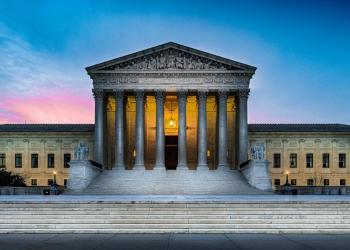
Officers Kneeling on an Arrestee’s Back and Civil Liability
Kneeling on an armed, potentially violent, suspect’s back for eight seconds while handcuffing him, does not necessarily subject the offending officer to federal civil liability for using excessive force. Absent prior case law to the contrary, the officer is entitled to qualified immunity.
Plaintiff Ramon Cortesluna had a drinking problem; getting violent and abusive with his live-in girlfriend and her two daughters (ages 12 and 15) when he drank. On the evening of November 6, 2016, he did just that, chasing them all into a back room where they managed to barricade themselves. Twelve-year-old I.R. called 911, telling the operator that they were all barricaded in a room because plaintiff was “always drinking,” had “anger issues,” was “really mad,” and was breaking up the house with a chainsaw and was going to hurt them. I.R. further reported that her mother was holding the door closed to prevent plaintiff from entering and hurting them. I.R.’s older sister then came on the line, telling the operator that plaintiff was “sawing on the door knob” as they spoke. The 911 operator could hear a sawing sound as she talked to the two girls. This information was passed on to Union City police units in the area, resulting in five officers—including the eventual civil defendants in this case, one of whom was Daniel Rivas-Villegas—responding to the scene. Upon their arrival, the officers found the house to be quiet. But they could see plaintiff through a window, holding nothing more than a beer. Checking back with the dispatcher, it was confirmed that the caller had reported that plaintiff had been using a chainsaw. The dispatcher further reported to the officers that during the 911 call, she heard sawing sounds in the background as if plaintiff were trying to saw the bedroom door down, and that the callers complained that they were unable to get out. As one officer stood by, ready with a beanbag shotgun, Officer Rivas-Villegas knocked on the front door, identified himself, and commanded plaintiff to come to the door. A few seconds later, plaintiff emerged from a nearby sliding glass door, holding a large metal object that looked like a crowbar (described in the Nine Circuit’s decision as a “pick tool”). Ordered to drop it, he did. Officer Rivas-Villegas then ordered plaintiff to “come out, put your hands up, walk out towards me.” Plaintiff complied. Officer Rivas-Villegas told plaintiff to “keep coming.” Plaintiff continued to comply, walking out of the house towards the officers. When plaintiff was about ten or eleven feet from the officers, Officer Rivas-Villegas told him “stop” and “get on your knees.” Plaintiff stopped as ordered, but failed to drop to his knees. As plaintiff stood there, another officer observed a knife in the front left pocket of his sweatpants, announcing to the other officers that plaintiff had “a knife in his left pocket, knife in his pocket!” An officer commanded plaintiff not to put his hands down. Plaintiff ignored the officer’s orders by simultaneously lowering his head and his hands. Plaintiff was immediately shot twice with beanbag rounds as his hands were still in a downward position, hitting him in the belly and hip. Plaintiff again raised his hands over his head and then, when ordered again, lowered himself to the ground. As he was doing so, Officer Rivas-Villegas used his foot to push plaintiff flat on the ground. Once down, Officer Rivas-Villegas pressed his knee into plaintiff’s back on the side where the knife was, and pulled his arms behind his back so that another officer could handcuff him. Plaintiff was held in this position with Officer Rivas-Villegas’ knee in his back for no more than eight seconds. Officer Rivas-Villegas then lifted plaintiff up by his handcuffed hands and moved him away from the doorway. Plaintiff’s girlfriend and her two daughters were found safe and unharmed in the house. (Unknown if they ever found a chainsaw.) Plaintiff later filed a civil suit in federal court (per 42 U.S.C. § 1983) alleging (1) the use of excessive force in shooting him with a beanbag shotgun and (2) Officer Rivas-Villegas’ use of excessive force by kneeling on him while he was on the ground. As a result of the officers’ actions, plaintiff claimed that he suffered “physical, emotional, and economic injuries.” The federal district (trial) court granted the civil defendants’ (i.e., the officers) respective summary judgment motions, ruling that that the force used by the officers was objectively reasonable under the circumstances and that they were entitled to qualified immunity. Plaintiff Appealed. The Ninth Circuit Court of Appeal, in a partial reversal, agreed with the trial court that use of the beanbag shotgun was reasonable and that the officers were entitled to qualified immunity on that issue. However, it was also held, in a split (2-to-1) decision, that Officer Rivas-Villegas was not entitled to qualified immunity for kneeling on plaintiff’s back, finding that their prior decision in LaLonde v. County of Riverside (9th Cir. 2000) 204 F. 3rd 947, put the officer on notice that kneeling on a non-resisting subject’s back constituted excessive force and a Fourth Amendment violation. The Ninth Circuit therefore reversed the trial court on that issue. (See Cortesluna v. Leon (9th Cir. Oct. 27, 2020) 979 F.3rd 645, briefed at California Legal Update, Vol. 26, #2, dated Jan. 18, 2021.) Officer Rivas-Villegas petitioned for certiorari to the United States Supreme Court.






